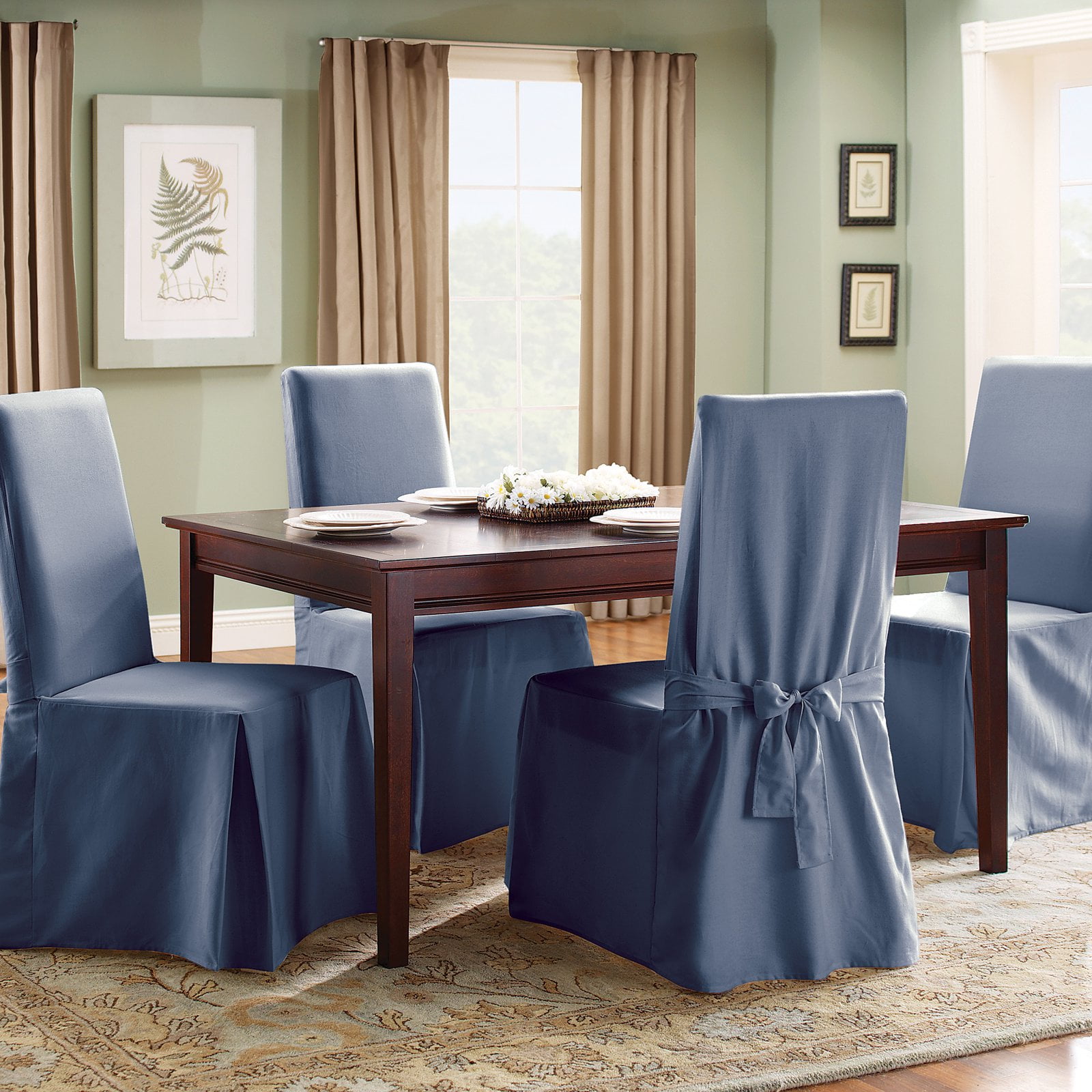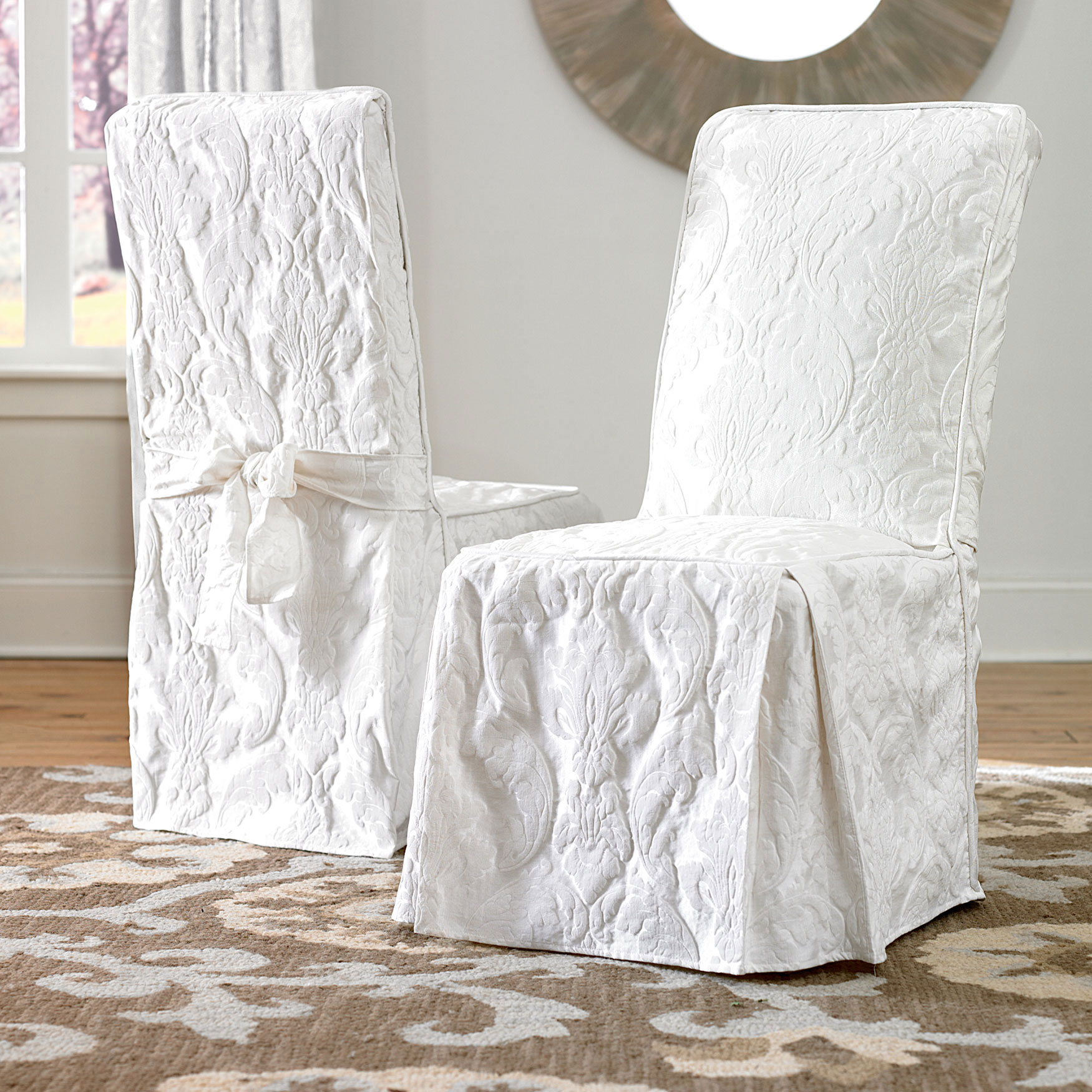Types and Styles of Tailored Dining Chair Slipcovers

Tailored dining chair slipcovers offer a versatile and cost-effective way to refresh the look of your dining room. Understanding the various materials, styles, and color palettes available allows for informed decision-making, ensuring the final product complements your existing décor and meets your functional needs. This section explores the key factors to consider when choosing tailored dining chair slipcovers.
Materials Used in Tailored Dining Chair Slipcovers
The choice of material significantly impacts the slipcover’s durability, comfort, and overall aesthetic. The following table summarizes the pros and cons of common materials:
| Material | Durability | Comfort | Price Range |
|---|---|---|---|
| Linen | Moderate; prone to wrinkling but durable with proper care. | Breathable and soft against the skin; can feel slightly rough initially. | Medium to High |
| Cotton | Good; relatively easy to clean and maintain. | Soft and comfortable; wide range of weights and textures available. | Low to Medium |
| Velvet | Good; resistant to wear and tear; may show lint. | Luxurious and soft; can be warm in warmer climates. | Medium to High |
| Polyester | High; wrinkle-resistant and easy to clean. | Can feel less breathable than natural fibers; may feel less luxurious. | Low to Medium |
| Microfiber | High; stain-resistant and easy to clean. | Soft and smooth; durable and easy to maintain. | Low to Medium |
Styles of Tailored Dining Chair Slipcovers
Different styles cater to various aesthetic preferences and chair designs. Consider the existing style of your dining chairs and the overall ambiance of your dining room when making your selection.
The suitability of each style depends on the chair’s shape and the desired level of formality.
- Fitted Slipcovers: These slipcovers are designed to hug the chair tightly, offering a sleek and tailored look. They are ideal for chairs with a defined shape and are suitable for formal dining rooms. Examples include slipcovers for classic Chippendale chairs or modern minimalist designs.
- Loose Slipcovers: These slipcovers drape loosely over the chair, creating a relaxed and casual atmosphere. They are a good choice for chairs with less defined shapes and work well in informal dining spaces. Examples include slipcovers for rustic farmhouse-style chairs or comfortable upholstered chairs.
- Tailored Slipcovers (Semi-Fitted): These offer a balance between fitted and loose styles, providing a more structured look than loose slipcovers but with more flexibility than fully fitted ones. They are versatile and suit a range of chair styles and dining room aesthetics. Examples include slipcovers for traditional dining chairs or transitional-style furniture.
Visual Impact of Color and Pattern
Color and pattern significantly influence the dining room’s atmosphere. Strategic choices can create a desired mood.
- Palette 1: Cool and Serene: A palette of soft blues, greens, and grays with subtle patterns like stripes or small florals creates a calming and peaceful ambiance. Imagine a dining room with pale blue slipcovers featuring a delicate white stripe pattern, complemented by light green accents. This evokes a feeling of tranquility and spaciousness.
- Palette 2: Warm and Inviting: Rich earth tones like terracotta, beige, and olive green, paired with geometric patterns or subtle damasks, foster a warm and welcoming atmosphere. Picture a dining room with terracotta-colored slipcovers featuring a simple geometric pattern, accented by warm beige walls and wooden furniture. This creates a sense of comfort and intimacy.
- Palette 3: Bold and Dramatic: Deep jewel tones such as emerald green, sapphire blue, and ruby red, combined with bold patterns like large florals or paisley, add a touch of drama and sophistication. Visualize a dining room with emerald green slipcovers showcasing a large-scale floral pattern, complemented by dark wood furniture and gold accents. This creates a luxurious and striking atmosphere.
Finding and Purchasing Tailored Dining Chair Slipcovers

Acquiring the perfect tailored dining chair slipcovers involves careful planning and execution. From accurate measurements to selecting the right retailer, several key steps ensure a successful outcome, resulting in beautifully rejuvenated dining chairs that complement your room’s aesthetic.
Accurate Dining Chair Measurements, Tailored dining chair slipcovers
Precise measurements are crucial for a proper fit. Inaccurate measurements can lead to ill-fitting slipcovers that look sloppy and don’t provide adequate protection. Follow these steps to ensure accurate measurements:
- Seat Width: Measure the widest part of the chair seat. Imagine a line across the seat where it is widest and measure from edge to edge. Note: This measurement should be taken at the top of the seat cushion, not the base of the chair frame.
- Seat Depth: Measure the distance from the front to the back of the chair seat. Start at the front edge where someone would sit and measure to the back edge.
- Seat Height: Measure the height of the seat cushion from the floor to the top of the cushion.
- Back Height: Measure the height of the chair back from the seat to the top, noting any curves or angles. If the back is curved, measure the highest point. If it has an angled top, measure both the highest and lowest points.
- Back Width: Measure the widest part of the chair back at its widest point, usually at or near the shoulder level of a seated person.
- Armrest Height (if applicable): If your chairs have armrests, measure the height from the seat to the top of the armrest. Also measure the length of the armrest from the chair’s side to its end.
- Chair Leg Height: Measure the height of the chair legs from the floor to the bottom of the chair seat. This helps ensure the slipcover sits properly.
- Photography: Take several detailed photographs of each chair from different angles (front, side, back). These photos will help the retailer (or you) visualize the chair’s unique shape and features, especially if it has unusual curves or details.
Comparison of Retailers for Tailored Dining Chair Slipcovers
Choosing a retailer depends on your priorities—selection, price, and customer service. Here’s a comparison of potential retailers (Note: Specific pricing and reviews are subject to change and are based on general observations at the time of writing):
| Retailer | Selection Variety | Price Range | Customer Review Summary |
|---|---|---|---|
| Online Retailer A (Example: A large online marketplace) | Wide variety of styles, fabrics, and customization options; often includes many third-party sellers. | Wide range, from budget-friendly to high-end; significant price variation between sellers. | Mixed reviews; high volume of reviews makes it difficult to assess average quality; many reviews focus on shipping times and seller communication. |
| Online Retailer B (Example: A specialty slipcover company) | More focused selection; may specialize in certain styles or fabrics. | Mid-range to high-end; typically higher prices due to specialization and potentially higher quality materials. | Generally positive reviews; customers often praise the quality of materials and craftsmanship; fewer reviews overall compared to larger marketplaces. |
| Offline Retailer C (Example: A local furniture store) | Limited selection, often with in-store samples; less customization available. | Mid-range to high-end; pricing may be competitive with online retailers depending on location and sales. | Reviews vary depending on the store; feedback generally reflects the quality of in-person customer service and return policies. |
Factors to Consider When Choosing Slipcovers
Selecting the right slipcovers requires careful consideration of several key factors. The decision-making process can be simplified using a flowchart.
The flowchart would begin with a decision point: “Chair Style (Modern, Traditional, etc.)?” branching into different styles. Each style would then lead to a decision point regarding “Room Décor (Modern, Traditional, Rustic, etc.)?” Each of those options would branch to a final decision point of “Personal Preference (Color, Fabric, etc.)?” Each final choice would represent a category of slipcover suitable for the described style and decor. For example, a modern chair in a modern room might lead to a sleek, minimalist slipcover in a neutral color, while a traditional chair in a rustic room might lead to a slipcover in a warm, textured fabric.
